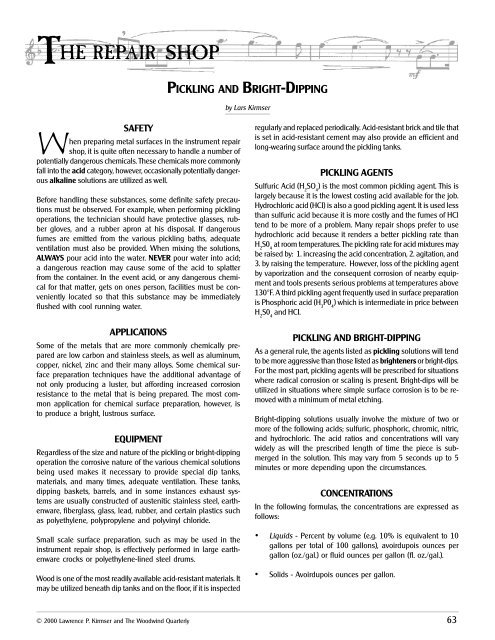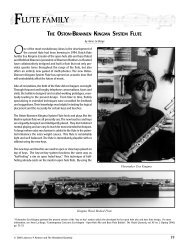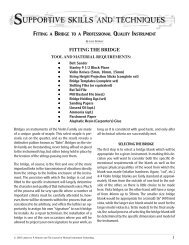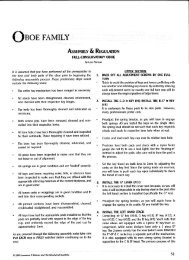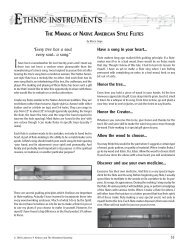PICKLING AND BRIGHT DIPPING - Music Trader Index Page
PICKLING AND BRIGHT DIPPING - Music Trader Index Page
PICKLING AND BRIGHT DIPPING - Music Trader Index Page
Create successful ePaper yourself
Turn your PDF publications into a flip-book with our unique Google optimized e-Paper software.
THE REPAIR SHOP<br />
SAFETY<br />
When preparing metal surfaces in the instrument repair<br />
shop, it is quite often necessary to handle a number of<br />
potentially dangerous chemicals. These chemicals more commonly<br />
fall into the acid category, however, occasionally potentially dangerous<br />
alkaline solutions are utilized as well.<br />
Before handling these substances, some definite safety precautions<br />
must be observed. For example, when performing pickling<br />
operations, the technician should have protective glasses, rubber<br />
gloves, and a rubber apron at his disposal. If dangerous<br />
fumes are emitted from the various pickling baths, adequate<br />
ventilation must also be provided. When mixing the solutions,<br />
ALWAYS pour acid into the water. NEVER pour water into acid;<br />
a dangerous reaction may cause some of the acid to splatter<br />
from the container. In the event acid, or any dangerous chemical<br />
for that matter, gets on ones person, facilities must be conveniently<br />
located so that this substance may be immediately<br />
flushed with cool running water.<br />
APPLICATIONS<br />
Some of the metals that are more commonly chemically prepared<br />
are low carbon and stainless steels, as well as aluminum,<br />
copper, nickel, zinc and their many alloys. Some chemical surface<br />
preparation techniques have the additional advantage of<br />
not only producing a luster, but affording increased corrosion<br />
resistance to the metal that is being prepared. The most common<br />
application for chemical surface preparation, however, is<br />
to produce a bright, lustrous surface.<br />
EQUIPMENT<br />
Regardless of the size and nature of the pickling or bright-dipping<br />
operation the corrosive nature of the various chemical solutions<br />
being used makes it necessary to provide special dip tanks,<br />
materials, and many times, adequate ventilation. These tanks,<br />
dipping baskets, barrels, and in some instances exhaust systems<br />
are usually constructed of austenitic stainless steel, earthenware,<br />
fiberglass, glass, lead, rubber, and certain plastics such<br />
as polyethylene, polypropylene and polyvinyl chloride.<br />
Small scale surface preparation, such as may be used in the<br />
instrument repair shop, is effectively performed in large earthenware<br />
crocks or polyethylene-lined steel drums.<br />
Wood is one of the most readily available acid-resistant materials. It<br />
may be utilized beneath dip tanks and on the floor, if it is inspected<br />
<strong>PICKLING</strong> <strong>AND</strong> <strong>BRIGHT</strong>-<strong>DIPPING</strong><br />
by Lars Kirmser<br />
regularly and replaced periodically. Acid-resistant brick and tile that<br />
is set in acid-resistant cement may also provide an efficient and<br />
long-wearing surface around the pickling tanks.<br />
<strong>PICKLING</strong> AGENTS<br />
Sulfuric Acid (H SO ) is the most common pickling agent. This is<br />
2 4<br />
largely because it is the lowest costing acid available for the job.<br />
Hydrochloric acid (HCI) is also a good pickling agent. It is used less<br />
than sulfuric acid because it is more costly and the fumes of HCl<br />
tend to be more of a problem. Many repair shops prefer to use<br />
hydrochloric acid because it renders a better pickling rate than<br />
H S0 at room temperatures. The pickling rate for acid mixtures may<br />
2 4<br />
be raised by: 1. increasing the acid concentration, 2. agitation, and<br />
3. by raising the temperature. However, loss of the pickling agent<br />
by vaporization and the consequent corrosion of nearby equipment<br />
and tools presents serious problems at temperatures above<br />
130°F. A third pickling agent frequently used in surface preparation<br />
is Phosphoric acid (H P0 ) which is intermediate in price between<br />
3 4<br />
H S0 and HCI.<br />
2 4<br />
<strong>PICKLING</strong> <strong>AND</strong> <strong>BRIGHT</strong>-<strong>DIPPING</strong><br />
As a general rule, the agents listed as pickling solutions will tend<br />
to be more aggressive than those listed as brighteners or bright-dips.<br />
For the most part, pickling agents will be prescribed for situations<br />
where radical corrosion or scaling is present. Bright-dips will be<br />
utilized in situations where simple surface corrosion is to be removed<br />
with a minimum of metal etching.<br />
Bright-dipping solutions usually involve the mixture of two or<br />
more of the following acids; sulfuric, phosphoric, chromic, nitric,<br />
and hydrochloric. The acid ratios and concentrations will vary<br />
widely as will the prescribed length of time the piece is submerged<br />
in the solution. This may vary from 5 seconds up to 5<br />
minutes or more depending upon the circumstances.<br />
CONCENTRATIONS<br />
In the following formulas, the concentrations are expressed as<br />
follows:<br />
• Liquids - Percent by volume (e.g. 10% is equivalent to 10<br />
gallons per total of 100 gallons), avoirdupois ounces per<br />
gallon (oz./gal.) or fluid ounces per gallon (fl. oz./gal.).<br />
• Solids - Avoirdupois ounces per gallon.<br />
© 2000 Lawrence P. Kirmser and The Woodwind Quarterly 63
Pickling and Bright-Dipping The Repair Shop<br />
Sulfuric acid - Commercial 66° Bé (93% H 2 S0 4 ). Sometimes<br />
expressed as oz./gal. of the 66° Bé acid.<br />
Hydrochloric acid - Commercial 20° Bé (31% HCI muriatic<br />
acid).<br />
Nitric acid - Commercial 42° Bé (67% HNO 3 ).<br />
Phosphoric acid - 75%<br />
Fluboric acid - 47% by weight.<br />
Acetic acid -- 99.5%<br />
<strong>PICKLING</strong> <strong>AND</strong> <strong>BRIGHT</strong>ENING SOLUTIONS<br />
Iron and Steel Pickles<br />
1.<br />
Water .............................................................................................. 1 part (by vol.)<br />
Hydrochloric acid ..................................................................... 1 part (by vol.)<br />
Room Temperature<br />
Water .............................................................................................. 1 gal.<br />
Sulfuric acid ................................................................................ 1 pint<br />
Room temperature up to 175°F<br />
Sulfuric acid ................................................................................ 8 fl. oz./gal.<br />
Hydrochloric acid ..................................................................... 10 fl. oz./gal.<br />
Room Temperature<br />
2.<br />
3.<br />
Iron and Steel Bright-dip<br />
4.<br />
Oxalic acid ................................................................................... 3.3 oz./gal.<br />
100 vol. hydrogen peroxide ............................................. 1.7 oz./gal.<br />
Sulfuric acid ................................................................................ 0.01 oz./gal.<br />
Room Temperature<br />
Stainless Steel Pickle<br />
5.<br />
Sulfuric acid ................................................................................ 1/2 pt./gal.<br />
Hydrofluoric acid ...................................................................... 1/2 pt./gal.<br />
Chromic acid .............................................................................. 8 oz./gal.<br />
Room Temperature or elevated<br />
Stainless Steel Bright-dip<br />
6.<br />
Nitric acid ..................................................................................... 4 parts (by vol.)<br />
Muriatic acid .............................................................................. 1 part (by vol.)<br />
Phosphoric acid ........................................................................ 1 part (by vol.)<br />
Acetic acid ................................................................................... 5 parts (by vol.)<br />
Temperature at 160°F<br />
Nickel and Nickel Alloy Pickles<br />
7.<br />
Water .............................................................................................. 5 gal.<br />
Sulfuric acid ................................................................................ 1 pt.<br />
Sodium dichromate ................................................................ 1/2 lb.<br />
Room Temperature or elevated<br />
64 © 2000 Lawrence P. Kirmser and The Woodwind Quarterly<br />
8.<br />
Water .............................................................................................. 2 gal.<br />
Hydrochloric acid ..................................................................... 1 gal.<br />
Cupric chloride ......................................................................... 1/2 lb.(optional)<br />
Temperature 180°F.<br />
Sulfuric acid ................................................................................ 1 pt./gal.<br />
Sodium nitrate .......................................................................... 3/4 lb./gal.<br />
Sodium chloride ....................................................................... 3/4 lb./gal.<br />
Temperature 180 - 190°F.<br />
Nickel and Nickel Alloy Bright-dip<br />
10.<br />
Phosphoric acid ........................................................................ 60% (by vol.)<br />
Sulfuric acid ................................................................................ 20% (by vol.)<br />
Nitric acid ..................................................................................... 20% (by vol.)<br />
Use at 180°F; dipping time 1 to 3 minutes<br />
9.<br />
Copper and Copper Alloy Bright-dip<br />
The copper-rich alloys are usually resistant to attack by sulfuric acid<br />
while copper oxide is readily attacked. For this reason, sulfuric acid<br />
is most often used as the pickling agent for radical corrosion and<br />
scaling on copper and copper alloys. A solution containing 5 to 10<br />
percent H SO by volume often gives a good pickling rate at room<br />
2 4<br />
temperature.<br />
Bright dips for copper and copper alloys consist usually of nitric<br />
and sulfuric acids in varying proportions together with small<br />
quantities of water and, hydrochloric acid. A common formula<br />
will consist of:<br />
11.<br />
Water .............................................................................................. 1 1/2 gal.<br />
Sulfuric acid ................................................................................ 2 gal.<br />
Nitric acid ..................................................................................... 1 gal.<br />
Hydrochloric acid ..................................................................... 1/2 fl. oz.<br />
Room temperature
The Repair Shop Pickling and Bright-Dipping<br />
12.<br />
Nitric acid ..................................................................................... 20% (by vol.<br />
Acetic acid ................................................................................... 25% (by Vol.)<br />
Phosphoric acid ........................................................................ 55% (by vol.)<br />
Hydrochloric acid ..................................................................... 0.5% (by vol.)<br />
Use at 190°F<br />
13.<br />
Nitric acid ..................................................................................... 40% (by vol.)<br />
Phosphoric acid ........................................................................ 30% (by vol.)<br />
Acetic acid ................................................................................... 30% (by vol.)<br />
Sodium Chloride ...................................................................... 1.0%<br />
Use at 150°F<br />
The hydrochloric acid is added to increase the luster but an<br />
excess of this compound will tend to cause the surface to spot.<br />
Sodium chloride may be used in place of the hydrochloric acid<br />
in this formula. After bright-dipping and rinsing thoroughly in<br />
cold running water, the piece may be dipped into a solution of 4<br />
oz./gal. of sodium cyanide to remove the remaining stains. It<br />
may then be thoroughly rinsed again in cold running water,<br />
and then dried.<br />
Silver Bright-dip<br />
14.<br />
Water .............................................................................................. 1 gal.<br />
Nitric acid ..................................................................................... 2 gal.<br />
Room Temperature or elevated<br />
15.<br />
Sulfuric acid ................................................................................ 1 gal.<br />
Nitric acid ..................................................................................... 1 pt.<br />
Room Temperature or elevated<br />
Work should be dry<br />
REMOVAL OF SOFT SOLDER<br />
Chemical removal of excess soft solder often results in a reduction<br />
in subsequent buffing and finishing efforts. Some repairpersons<br />
use a solution of 1 part water to 1 part nitric acid at room temperature<br />
to remove excess soft solder. Another method is to immerse in<br />
10% fluoboric acid (1 vol. 42% HBF to 3 vol. water) containing 6.5<br />
4<br />
fl. oz./gal. of 30% hydrogen peroxide. This solution may be used at<br />
room temperature resulting in an immersion time varying from 5 to<br />
15 minutes or longer. The stripping action of this solution may be<br />
accelerated by making it electrolytic. The piece is made to be the<br />
anode (+) at 1 - 2 volts, with lead used as the cathodes (-). If this<br />
method is used, the lead cathodes must be removed and rinsed<br />
thoroughly after each use since they would dissolve if allowed to<br />
remain in the acid solution. Caution should be taken not to allow<br />
the base metal to etch due to excessive duration of treatment.<br />
REMOVAL OF SILVER SOLDER FLUX<br />
The following solutions may be used to remove the stubborn borax<br />
or silver solder flux that will remain after silver soldering: Mix 9<br />
parts water with 1 part sulfuric acid. A second solution would be to<br />
mix 7 parts water, 1 part Nitric acid, and 2 parts sulfuric acid.<br />
THE COLORING OF METALS<br />
Although the practice of chemically coloring or oxidizing metals is<br />
not necessarily inherent to the field of musical instrument repair,<br />
there is the chance that some of our readers are currently engaged<br />
in the restoration of antiques to which many of the following formulas<br />
may be applied.<br />
An almost unlimited variety of shades and colors may be applied<br />
to metals by using chemical solutions. The outcome will<br />
depend, for the most part, upon the skill of the technician, more<br />
so than the particular formula used. The results will also vary<br />
with the slight composition differences of similar metal alloys.<br />
Contrast in color may be obtained by scratch-brushing with fine<br />
pumice, hand rubbing with a pumice paste, or by buffing.<br />
BLACK ON BRASS:<br />
Copper carbonate .................................................................... 1 lb.<br />
Ammonia ..................................................................................... 1 qt.<br />
Water .............................................................................................. 2 1/2 qts.<br />
Temperature................................................................................ 175°F<br />
The copper carbonate and the ammonia are thoroughly mixed<br />
before adding the water. An excess of copper must be present.<br />
The color, which is a blue black, may be fixed by a subsequent<br />
dip in a 2 1/2% solution of caustic soda.<br />
GRAY BLACK ON BRASS:<br />
Hydrochloric acid ..................................................................... 1 gal.<br />
White arsenic ............................................................................ 2 lbs.<br />
Anitmony trichloride ............................................................. 1 1/4 Ibs.<br />
This solution is used hot and no water should be added.<br />
BLUE ON BRASS:<br />
Lead acetate ............................................................................... 2 - 4 oz.<br />
Sodium thiosulfate ................................................................. 8 oz.<br />
Acetic acid ................................................................................... 4 oz.<br />
Water .............................................................................................. 1 gal.<br />
Temperature................................................................................ 180°F<br />
This will produce a blue color on a nickel deposit and also on<br />
polished high carbon steel. The color will change if not lacquered.<br />
© 2000 Lawrence P. Kirmser and The Woodwind Quarterly 65
Pickling and Bright-Dipping The Repair Shop<br />
ANTIQUE GREEN ON BRASS:<br />
Nickel ammonium sulfate ................................................. 8 oz.<br />
Sodium thiosulfate ................................................................. 8 oz.<br />
Water .............................................................................................. 1 gal.<br />
Temperature................................................................................ 160°F<br />
HARDWARE GREEN ON BRASS:<br />
Ferric nitrate ............................................................................... 1 oz.<br />
Sodium thiosulfate ................................................................. 6 oz.<br />
Water .............................................................................................. 1 gal<br />
Temperature................................................................................ 160°F<br />
BROWN ON BRASS OR COPPER:<br />
Potassium chlorate................................................................. 5 1/2 oz.<br />
Nickel sulfate ............................................................................. 2% oz.<br />
Copper sulfate ........................................................................... 24 oz.<br />
Water .............................................................................................. 1 gal.<br />
Temperature................................................................................ 195° - 212°F<br />
CRYSTALLIZED BRASS:<br />
Copper sulfate ........................................................................... 8 oz.<br />
Ammonium chloride ............................................................. 4 oz.<br />
Water .............................................................................................. 1 gal.<br />
Solution may be used either cold or warm. After the crystallized<br />
effect has been obtained, a dip in a sulfide solution will bring<br />
out the crystal effect even more distinctly.<br />
LIGHT BROWN ON BRASS OR COPPER:<br />
Barium sulfide .......................................................................... 1/2 oz.<br />
Ammonium carbonate ........................................................ 1/4 oz.<br />
Water .............................................................................................. 1 gal.<br />
The color is made to be more clear by wet scratch brushing<br />
and repeating the dipping.<br />
BLACK ON COPPER:<br />
Immerse at room temperature in a solution of 1/4 oz./gal. liver<br />
of sulfur or liquid polysulfied. Colors will progress through the<br />
spectrum from yellow to dark purple to black. The strength of<br />
the solution should be such that the black color forms in about<br />
1 minute. If it forms much more rapidly, the copper sulfide film<br />
will be brittle and non-adherent, in which case the concentration<br />
should be reduced.<br />
STATUARY BRONZE ON COPPER:<br />
The same procedure and solution are employed as above for<br />
black on copper. However, the articles are removed when they<br />
show a reddish-purple iridescence, and rinsed. Dry<br />
scratch-brushing will then result in a chocolate brown color.<br />
BLUEING STEEL:<br />
The following baths will produce a blue color on steel:<br />
1.<br />
Ferric chloride ........................................................................... 2 oz.<br />
Mercuric nitrate ........................................................................ 2 oz.<br />
Hydrochloric acid ..................................................................... 2 oz.<br />
Alcohol .......................................................................................... 8 oz.<br />
Water .............................................................................................. 8 oz.<br />
Use at room temperature. Parts are immersed for 20 min., removed<br />
and allowed to stand in air for 12 hours. Repeat this<br />
again, then boil in water for 1 hour. Dry, scratchbrush and oil.<br />
2.<br />
Sodium thiosulfate ................................................................. 8 oz./gal.<br />
Lead acetate ............................................................................... 2 oz./gal.<br />
Use at boiling temperature.<br />
3.<br />
White arsenic ............................................................................ 16 oz.<br />
Hydrochloric acid ..................................................................... 1 gal.<br />
Water .............................................................................................. 1/2 gal.<br />
Use warm.<br />
4.<br />
Mercuric chloride .................................................................... 4 parts<br />
Potassium chlorate................................................................. 3 parts<br />
Alcohol .......................................................................................... 8 parts<br />
Water .............................................................................................. 85 parts<br />
Temperature................................................................................ Room<br />
5.<br />
Caustic soda ............................................................................... 5 oz./gal.<br />
White arsenic ............................................................................ 5 oz./gal.<br />
Sodium cyanide ........................................................................ 1 oz./gal<br />
Make parts cathodic, using steel anodes, at 2 amp./ft. 2<br />
for 2 -4<br />
minutes. The blue color produced should be rubbed and oiled.<br />
Bobby came home from school one day and said to his<br />
mom, “Mommy, I learned the alphabet today! The rest of<br />
the class could only get up to F I got all the way through!”<br />
His mom replied, “That’s because you’re a violist, Bobby”.<br />
The next day came and Bobby said, “Mommy, I counted to<br />
a hundred in school today. Everybody else could only get<br />
to 60.” “That’s because you’re a violist, dear,” came the<br />
reply. So again, the very next day Johnny came home with,<br />
“Mommy, I’m taller that everyone in my class. Is that because<br />
I’m a violist?” “No dear, that’s because you’re 26.”<br />
<br />
<br />
66 © 2000 Lawrence P. Kirmser and The Woodwind Quarterly


